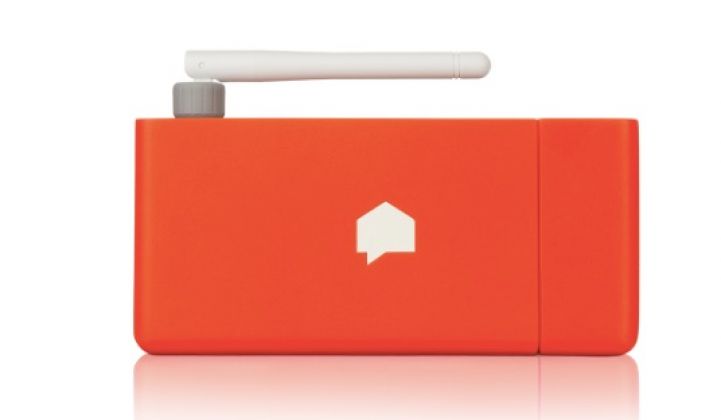For the past few years, we’ve been tracking different energy disaggregation technologies that can take whole-home energy data -- say, smart meter or circuit panel sensor data -- and turn it into breakouts of how much electricity is being used by the air conditioner, the heater, and other major appliances in the home. While there are lots of different approaches to this challenge, the fundamental rule appears to be that the more data you can collect, the more accurate the results can be.
Sense has decided to take the super-accurate approach to energy disaggregation, building on work in the speech recognition field. The Cambridge, Mass.-based startup says its $299 devices can sample data from a home’s circuit panel a million times per second, and convert that into very granular and timely information on what’s on and off in the home.
It’s so accurate, in fact, that Sense says it can alert its users the moment an oven is turned on, a sump pump is activated, or a garage door is opened. That’s a level of accuracy that goes pretty far beyond what most disaggregation providers are offering today -- and that, CEO and co-founder Michael Phillips says, could be a key feature to get consumers engaged.
On Thursday, Sense announced it has raised a $14 million Series A financing to bring this proposition to the test. New investors Shell Technology Ventures and Energy Impact Partners led the round, along with previous seed investors Capricorn Investment Group, Prelude Ventures, CRV and hardware accelerator Bolt.
Sense has previously raised about $5.6 million since its 2013 founding, Phillips said in an interview this week. It’s also been testing its product for some time, “in a quiet, pre-launch kind of way,” selling to DIY users through its website, he said. “It’s nice to get consumer feedback prior to full-scale production.”
“This new funding is to scale up manufacturing -- we’re getting caught up with our backlog, based on preorders,” he said. The money will also go to hire more software engineers and scientists to work on the “data science and data technology side” of the company, said Phillips, whose work in speech recognition stretches back decades to his co-founding of SpeechWorks in 1994 and Vlingo in 2006.
Some of this technology ended up finding its way into Samsung’s S-Voice and Apple’s Siri. In a sense, parsing out lots of different appliances' and devices’ energy signatures from a single circuit is “kind of like speech recognition, but with 30 people talking at the same time,” he said.
The high rate of data sampling needed requires a piece of in-home equipment -- in Sense’s case, induction clamps for the home’s electrical mains that link to a box that processes much of the data and connects via household Wi-Fi to the internet.
That makes Sense’s approach more expensive than disaggregation technologies from companies like Bidgely or Plotwatt, which can use smart meter data to deliver fairly accurate estimates of energy use across broad categories like cooling, heating and lighting.
But with that equipment, Sense can deliver a lot more information to its users, once its device has been installed and collecting data for about a month or so. “We’re now finding on average 16 [discrete data streams] per house, and about half of those things, we know what they are -- the garage door, the microwave, the refrigerator,” he said. “Then there are things like ‘unknown motor number two,’ and you’ll tell us, ‘Oh, that’s my aquarium pump motor.’”
Sense’s smartphone app allows its users to identify and verify the status of these individual systems in the home, and then starts to track them on a real-time basis, he said. Much of the data processing is done in the device itself.
“You can set up alerts yourself, telling you the toaster was on this morning, the drain pump was on, the garage door was opened,” he said. Compared to after-the-fact reports, this real-time information “is the stuff people care about -- is my kid home from school, did I leave the oven on, is the dryer load done. And to really make this engaging, it has to be this real-time, detailed view.”
Lots of smart-home technology vendors have enabled this kind of data feedback down to individual networked devices, he said. But it’s hard to name a vendor that’s promised the same kind of detailed, real-time view of non-networked, “dumb” devices using only disaggregation, although companies such as Smappee, Belkin and Intel have demonstrated in-home devices with similar data-collection capabilities.
Of course, “in exposing the data in this super-detailed way, we have to be super-accurate,” Phillips said. “We don’t want to tell you your garage door opened in the middle of the night when it didn’t.”
Thursday’s funding announcement also comes with news that Sense has expanded support for smartphones using the Android operating system as well as its existing iPhone app, he said. The startup has also added support for monitoring home solar PV system production, a feature that’s been popular for other disaggregation providers looking to solar households as a likely early-adopter target market for their technology.
“So far we’ve been doing this in a direct-to-consumer way,” he added. “We’re starting to have discussions with potential partners to get it to market at larger scales.” That could include Sense’s new investors, he said.
Shell Technology Ventures Managing Director Geert van de Wouw noted in Thursday’s press release that Shell is “exploring opportunities to bring Sense’s capabilities to our business and customers.” And Hans Kobler, managing partner of Energy Impact Partners, an investment consortium of utilities including Southern Company, Xcel Energy, Oncor and National Grid, added that the group is interested in technologies that can “provide broad home intelligence.”



